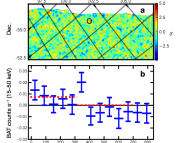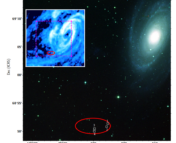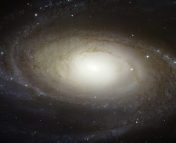Title: A repeating FRB in a dense environment with a compact persistent radio source
Authors: C.-H. Niu, K. Aggarwal, D. Li, X. Zhang, S. Chatterjee, C.-W. Tsai, W. Yu, C. J. Law, S. Burke-Spolaor, J. M. Cordes, Y.-K. Zhang, S. Ocker, J.-M. Yao, P. Wang, Y. Feng, Y. Niino, C. Bochenek, M. Cruces, L. Connor, J.-A. Jiang, S. Dai, R. Luo, G.-D. Li, C.-C. Miao, J.-R. Niu, R. Anna-Thomas, J. Sydnor, D. Stern, W.-Y. Wang, M. Yuan, Y.-L. Yue, D.-J. Zhou, Z. Yan, W.-W. Zhu, B. Zhang
First Author’s Institution: National Astronomical Observatories Chinese Academy of Sciences
Status: Nature [Submitted — Closed Access]
In 2007, when combing through some archival radio data, astronomers happened upon a rather exciting discovery: they found a very bright (~10x stronger than the sun) and very short (~millisecond) burst of radio emission coming from outside of the Milky Way. This burst, and others similar to it, are now known as fast radio bursts. As given away by their name, fast radio bursts (abbreviated “FRBs”) are really fast (~milliseconds) bursts of radio emission. FRBs are a rather mysterious phenomena, with the astronomical source along with the physical mechanism for them still unknown!
FRBs have primarily been detected in galaxies outside of the Milky Way, but in 2020 an FRB-like burst was detected within our own Galaxy from a well-known magnetar, SGR 1935-2154. Magnetars, a type of rapidly rotating neutron star with a REALLY (~1014 G) strong magnetic field (for comparison, the earth’s magnetic field is only ~0.5 G), are one possible source for FRBs, so this was a really exciting (and promising) discovery for theories that include magnetars.
Roughly ten years after the discovery of the first FRBs, astronomers found another very exciting discovery: an FRB that repeats! Known as FRB 20121102, this FRB is now one of the most commonly studied FRBs. It is a highly active FRB, with ~1600 bursts detected from the source within 50 days. It is also possibly periodic, with a suggested periodicity of ~157 days. FRB 20121102 lives in a dwarf galaxy, a “miniature” galaxy with ~200x less stars than the Milky Way. Continued observations of FRB 20121102 showed that it also lived in a rather extreme magnetic environment. Lastly, and most importantly to today’s bite, astronomers found a persistent, compact radio source at the same location as the FRB.
However, since FRB 20121102, no other FRB had been found to be coincident with a persistent, compact radio source… until today’s discovery!
Lot’s of bursts!
Today’s authors found another FRB coincident with a persistent radio source! The FRB, known as FRB 20190520B, was discovered using the Five-hundred-meter Aperture Spherical radio Telescope (FAST). FAST is currently the world’s largest single dish radio telescope, and as such has incredible sensitivity for detecting lots of faint bursts from FRBs. Similar to FRB 20121102, FRB 20190520B is a very active repeater, with a rate of ~4.5 bursts per hour (see Fig. 1 for examples of some cool bursts from this source).
The team followed up FRB 20190520B using the Karl G. Jansky Very Large Array, and were able to localize the FRB to ~0.1 arcseconds (equivalent to 0.00002 degrees). Past optical data from the CFHT/MegaCam revealed a dwarf galaxy at the exact same location as the FRB. The authors found the chance of this happening by chance to be 0.8%, hence concluding that the dwarf galaxy was likely the host of FRB 20190520B. To determine the redshift of this galaxy, they obtained an optical spectrum of the galaxy using the Palomar 200-inch Hale Telescope and compared the predicted vs. observed Hα emission lines, with the difference between the two dependent on the redshift of the galaxy.
When combined with the dispersion measure of the FRB (a measure of the total electron density between us and the FRB), the redshift of the host is rather interesting. The FRB has a much larger dispersion measure for its redshift (aka distance) than might be predicted! The authors attribute this “extra” electron density to the dwarf galaxy itself rather than the Milky Way or the intergalactic medium.
The observations with the Very Large Array also revealed a persistent, compact radio source near the same location as the FRB (see Fig. 2). While it is possible that this radio emission originates from the host galaxy, today’s authors argue against it for three reasons: 1) it has a VERY high luminosity (if the galaxy were responsible for this luminosity, then it would need to have a rather unrealistic level of star formation), 2) it’s compact, and 3) it’s location is offset from the center of the optical emission from the galaxy.
A sibling to FRB 20121102?
Now that we’ve presented the basics on FRB 20190520B, let’s compare it to FRB 20121102. Both FRBs 1. have very high repetition rates, 2. are located in dwarf galaxies, and 3. are coincident with persistent, compact radio sources. This suggests that these two FRBs may be a special “class” of FRBs. One possibility is that they are particularly young FRBs, still located in their “natal” environments e.g. a young supernova remnant or a relativistic wind nebula. As these environments typically consist of dense, magnetized plasma, this could explain both the high dispersion measures and the high activity rate (assuming the FRB emission mechanism, and hence the activity rate, is directly connected to the properties of the surrounding medium).
However, there have been a number of other FRBs with high activity rates for which persistent compact radio sources have not been found. Thus, the distinction between a class of “young” FRBs associated with persistent radio sources and another class of FRBs is likely much more nuanced than just a high vs. low repetition rate.
Astrobite edited by Viraj Karambelkar
Featured image credit: Danielle Futselaar





Fast Radio Durst or Fast Radio Burst?